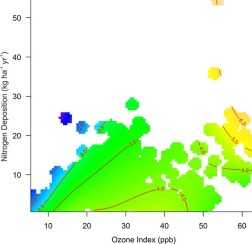当前位置:
X-MOL 学术
›
Forest Ecol. Manag.
›
论文详情
Our official English website, www.x-mol.net, welcomes your feedback! (Note: you will need to create a separate account there.)
Evaluating the effects of nitrogen and sulfur deposition and ozone on tree growth and mortality in California using a spatially comprehensive forest inventory
Forest Ecology and Management ( IF 3.7 ) Pub Date : 2020-06-01 , DOI: 10.1016/j.foreco.2020.118084 Mark E. Fenn , Haiganoush K. Preisler , Jeremy S. Fried , Andrzej Bytnerowicz , Susan L. Schilling , Sarah Jovan , Olaf Kuegler
Forest Ecology and Management ( IF 3.7 ) Pub Date : 2020-06-01 , DOI: 10.1016/j.foreco.2020.118084 Mark E. Fenn , Haiganoush K. Preisler , Jeremy S. Fried , Andrzej Bytnerowicz , Susan L. Schilling , Sarah Jovan , Olaf Kuegler

|
Abstract Although nitrogen deposition and tropospheric ozone have impacted California forests for decades, broad scale studies of these impacts on forest growth and mortality are lacking. Because of the summer-dry climate over most of the state, forest responses to air pollution are expected to differ from more mesic climates. In this study, data from US Forest Service Forest Inventory and Analysis (FIA) permanent (remeasured) plots were combined with modelled atmospheric N and S deposition and an ozone exposure index to evaluate tree growth and mortality responses in California. Seven of 18 species exhibited significantly greater carbon increment (CI) in tree boles as N deposition increased, though the magnitude of the effect was quite small in most California forests. However, increases in CI were substantial in the coastal ecosections of central and northern California where precipitation and fog exposure are greatest. Redwood (Sequoia sempervirens (D. Don) Endl.) trees exhibited the strongest CI response to N deposition. Our model results imply a mean CI increase of 4.2 kg ha−1 yr−1 of C per kg ha−1 yr−1 of N deposition statewide versus 13.6 in the Central and Northern California Coast ecosections, where > 50% of the trees are redwood or tanoak (Lithocarpus densiflorus (Hook. & Arn.) Rehd.). Increased carbon sequestration rates in response to N deposition in these California coastal regions were similar to increases reported for Europe and global estimates. Nitrogen and S deposition significantly increased the odds of top damage and trees with crown damage exhibited higher mortality, although the effect was small. Elevated ozone exposure was associated with significantly larger rates of overall tree growth. However, for ozone-sensitive ponderosa pine at moderate ozone levels (ozone index values of ca. 20–30 ppb) and moderately-elevated N deposition (15–25 kg ha−1 hr−1), CI begins to decline, before increasing at higher pollution levels, presumably because of the fertilizing effect of N deposition; although data are limited for these more polluted conditions. Sulfur deposition in California forests was low, ranging from 0.3 to 3.1 kg ha−1 yr−1, but was associated with positive growth response in seven coniferous species. The combined effect of N and S deposition and ozone exposure statewide is a net increase in bole CI. However, aridity reduces the stimulatory growth effect of N deposition, and alters the threshold, capacity and sometimes the direction (e.g., S deposition) of the CI response to deposition, factors that need to be considered in global change models.
中文翻译:

使用空间综合森林清单评估氮和硫沉积以及臭氧对加利福尼亚州树木生长和死亡率的影响
摘要 尽管氮沉降和对流层臭氧已经影响加州森林数十年,但缺乏对这些对森林生长和死亡率影响的大规模研究。由于该州大部分地区夏季气候干燥,预计森林对空气污染的反应将与更温和的气候不同。在这项研究中,来自美国林务局森林清查和分析 (FIA) 永久(重新测量)地块的数据与模拟的大气氮和硫沉积以及臭氧暴露指数相结合,以评估加利福尼亚的树木生长和死亡率响应。随着 N 沉积的增加,18 个物种中有 7 个在树的树干中表现出显着更大的碳增量 (CI),尽管在大多数加利福尼亚森林中这种影响的幅度很小。然而,在加利福尼亚州中部和北部的沿海生态区,降水和雾的暴露量最大,CI 的增加是显着的。红杉 (Sequoia sempervirens (D. Don) Endl.) 树对 N 沉积表现出最强的 CI 响应。我们的模型结果意味着全州范围内每公斤 ha-1 yr-1 N 沉积的 C 平均 CI 增加 4.2 kg ha-1 yr-1,而在加州中部和北加州海岸生态区则为 13.6,其中 > 50% 的树木是红木或 tanoak (Lithocarpus densiflorus (Hook. & Arn.) Rehd.)。这些加利福尼亚沿海地区因氮沉积而增加的碳固存率与欧洲和全球估计值报告的增加相似。氮和硫沉积显着增加了顶部损坏的几率,树冠损坏的树木死亡率更高,虽然影响很小。臭氧暴露升高与整体树木生长速度显着增加有关。然而,对于中等臭氧水平(臭氧指数值约为 20-30 ppb)和中等升高的 N 沉积(15-25 kg ha-1 hr-1)的臭氧敏感的黄松,CI 开始下降,然后增加在较高的污染水平下,大概是因为氮沉积的施肥作用;尽管这些污染更严重的条件的数据有限。加利福尼亚森林中的硫沉积量较低,范围为 0.3 至 3.1 kg ha-1 yr-1,但与七种针叶树种的正生长反应相关。N 和 S 沉积以及全州范围内的臭氧暴露的综合影响是 bole CI 的净增加。然而,干旱降低了氮沉积的刺激生长作用,并改变了阈值,
更新日期:2020-06-01
中文翻译:

使用空间综合森林清单评估氮和硫沉积以及臭氧对加利福尼亚州树木生长和死亡率的影响
摘要 尽管氮沉降和对流层臭氧已经影响加州森林数十年,但缺乏对这些对森林生长和死亡率影响的大规模研究。由于该州大部分地区夏季气候干燥,预计森林对空气污染的反应将与更温和的气候不同。在这项研究中,来自美国林务局森林清查和分析 (FIA) 永久(重新测量)地块的数据与模拟的大气氮和硫沉积以及臭氧暴露指数相结合,以评估加利福尼亚的树木生长和死亡率响应。随着 N 沉积的增加,18 个物种中有 7 个在树的树干中表现出显着更大的碳增量 (CI),尽管在大多数加利福尼亚森林中这种影响的幅度很小。然而,在加利福尼亚州中部和北部的沿海生态区,降水和雾的暴露量最大,CI 的增加是显着的。红杉 (Sequoia sempervirens (D. Don) Endl.) 树对 N 沉积表现出最强的 CI 响应。我们的模型结果意味着全州范围内每公斤 ha-1 yr-1 N 沉积的 C 平均 CI 增加 4.2 kg ha-1 yr-1,而在加州中部和北加州海岸生态区则为 13.6,其中 > 50% 的树木是红木或 tanoak (Lithocarpus densiflorus (Hook. & Arn.) Rehd.)。这些加利福尼亚沿海地区因氮沉积而增加的碳固存率与欧洲和全球估计值报告的增加相似。氮和硫沉积显着增加了顶部损坏的几率,树冠损坏的树木死亡率更高,虽然影响很小。臭氧暴露升高与整体树木生长速度显着增加有关。然而,对于中等臭氧水平(臭氧指数值约为 20-30 ppb)和中等升高的 N 沉积(15-25 kg ha-1 hr-1)的臭氧敏感的黄松,CI 开始下降,然后增加在较高的污染水平下,大概是因为氮沉积的施肥作用;尽管这些污染更严重的条件的数据有限。加利福尼亚森林中的硫沉积量较低,范围为 0.3 至 3.1 kg ha-1 yr-1,但与七种针叶树种的正生长反应相关。N 和 S 沉积以及全州范围内的臭氧暴露的综合影响是 bole CI 的净增加。然而,干旱降低了氮沉积的刺激生长作用,并改变了阈值,



























 京公网安备 11010802027423号
京公网安备 11010802027423号